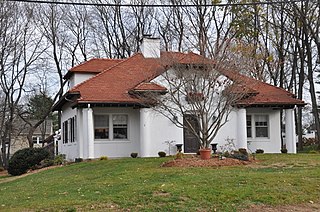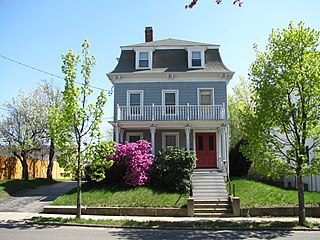Beth Israel may refer to:
This is a list of properties and historic districts in Wakefield, Massachusetts, that are listed on the National Register of Historic Places.

The Beacon Street Tomb is a historic receiving tomb in the Lakeside Cemetery of Wakefield, Massachusetts. Built about 1858, it is one of the finest examples of Greek Revival architecture. It was listed on the National Register of Historic Places in 1989.

The Lakeside Cemetery Chapel is a historic chapel in Lakeside Cemetery, on North Avenue in Wakefield, Massachusetts. The stone chapel, built 1913, is one of a few Neo-Gothic buildings in the town. Roughly resembling English country churches, the building has a steeply pitched slate roof, with sidewalls containing supporting buttresses. The front and rear of the chapel both have projecting entry sections that repeat the sharply pitched gable.

The Common Historic District is a historic district encompassing the civic and institutional heart of Reading, Massachusetts. The district is centered on the town common, at the intersection of Main and Salem Streets. The common has been communally owned since at least 1737, with the original burying ground to the north. In 1769 the area's first meeting house was built, giving the area a sense of identity separate from portions of Reading that would later be set off as Wakefield and North Reading. Since then the area has become a focal point for religious and civic institutions in the town.

The James Nichols House is a historic house in Reading, Massachusetts. Built c. 1795, this 1+1⁄2-story gambrel-roofed house is built in a vernacular Georgian style, and is a rare local example of the style. The house was built by a local shoemaker and farmer who was involved in a religious dispute that divided the town. The house was listed on the National Register of Historic Places in 1984.

The Elizabeth Boit House is a historic house at 127 Chestnut Street in Wakefield, Massachusetts.

The Emerson–Franklin Poole House is a historic house at 23 Salem Street in Wakefield, Massachusetts. Built about 1795, it was in the 19th century home to Franklin Poole, a locally prominent landscape artist. Some of its walls are adorned with the murals drawn by Rufus Porter. The house was listed on the National Register of Historic Places in 1989.

The Deacon Daniel Green House is a historic house at 747 Main Street in Wakefield, Massachusetts. It is a 2+1⁄2-story wood-frame house, with a gable roof and clapboard siding. It was built early in the Federal period (1750-1785), and is one of a few surviving examples of a local architectural variant, three bays wide and four bays deep. The house was occupied by Deacon Daniel Green in 1785, who moved to South Reading, from Stoneham.

The House at 5 Bennett Street in Wakefield, Massachusetts, is also known as the Wakefield House for Aged Women, and is one of the largest houses in Wakefield's Junction District. The original part of the house was built sometime between 1875 and 1881, with Italianate styling. It was probably built for an executive of the Wakefield Rattan Company. In 1894 the house was purchased by the Wakefield House for Aged Women, a charity established by local Protestant churches, and significantly expanded. During this major alteration some of the house's Italianate details were copied, and a Queen Anne style porch was added.

The House at 21 Chestnut Street is one of the best preserved Italianate houses in Wakefield, Massachusetts. It was built c. 1855 to a design by local architect John Stevens, and was home for many years to local historian Ruth Woodbury. The house was listed on the National Register of Historic Places in 1989.

The House at 20 Morrison Road in Wakefield, Massachusetts is a well-preserved Colonial Revival house. The 2+1⁄2-story wood-frame house originally had a semicircular portico, a relative rarity in Wakefield. The porch has turned balusters, and the three roof dormers have pedimented gable ends. The house was built about 1890 on land originally part of the large estate of Dr. Charles Jordan, that was developed in the 1880s as Wakefield Park.

The House at 88 Prospect Street in Wakefield, Massachusetts is one of three houses in the family compound of Elizabeth Boit. Built in 1913, the compound of which this house is a part is the only estate of one of Wakefield's major industrial figures to survive. The house was listed on the National Register of Historic Places in 1989.

The House at 90 Prospect Street in Wakefield, Massachusetts is one of three houses in the family compound of Elizabeth Boit. Built in 1913, the compound of which this house is a part is the only estate of one of Wakefield's major industrial figures to survive. The house was listed on the National Register of Historic Places in 1989.

The House at 12 West Water Street in Wakefield, Massachusetts is a rare local example of a Second Empire house. The wood-frame house was built around 1860, and has two full stories, and a third beneath the mansard roof. It is three bays wide, with a wide double-door entry, and a porch across the front with elaborately decorated posts. The house may have been built by Cyrus Wakefield, owner of the Wakefield Rattan Company, and sold to a company employee. A later owner was George Cox, who owned a billiard parlor in the town center.

The Dr. Charles Jordan House is a historic house at 9 Jordan Avenue in Wakefield, Massachusetts. Built c. 1885, it is one Wakefield's most elaborate Queen Anne Victorian houses. The 2+1⁄2-story wood-frame house is unusual for having a hipped roof; it also has a tower in the northwest corner, and a porch with Italianate pillars brackets. The house was built by Dr. Charles Jordan, a local physician and pharmacist with extensive land holdings in the area.

The Wakefield Rattan Company was the world's leading manufacturer of rattan furniture and objects in the second half of the 19th century. Founded by Cyrus Wakefield in 1851 in South Reading, Massachusetts, it perfected machinery for working with rattan, developing looms for weaving chair seats and mats. Its products also included wicker furniture and baby carriages. The company also successfully found uses for previously wasted portions of the plant, using shavings to create baling fabric and floor coverings. Its products were available throughout the United States.

The Wakefield Trust Company is a historic commercial building at 371 Main Street in Wakefield, Massachusetts. Built in 1924, it is one of three buildings on the west side of Main Street that give the town center a strong Classical Revival flavor. The building was listed on the National Register of Historic Places in 1989.

The Woodville School is a public elementary school at 30 Farm Road in Wakefield, Massachusetts. The present building was built in 2003, replacing an older building that was listed on the National Register of Historic Places in 1989.

The Jewish Cemetery of New Bedford, Massachusetts is located in the far north of the city, on Old Plainville Road, just north of New Bedford Regional Airport. The cemetery was established in 1898 as the principal burying ground for two congregations, Chesed Shel Emes and Ahavath Achim. It is the second Jewish cemetery in the city; the first, a small section of Peckham West Cemetery, was filled up in the 1890s. The developed portion of the cemetery lands is about 13 acres (5.3 ha), with another 24.5 acres (9.9 ha) that is undeveloped forest. The cemetery land is now owned by a number of organizations: the Tifereth Israel congregation owns about 19 acres (7.7 ha), Ahavath Achim owns 5.25 acres (2.12 ha), and two small parcels are owned by other organizations. Entrances to the cemetery are marked by stone posts with bronze plaques. There is also the Temple Sinai section that sits in the grounds of the New Bedford airport that was accessible from the Old Plainville Road but is now blocked off.




















